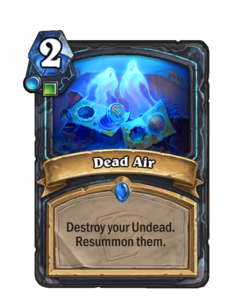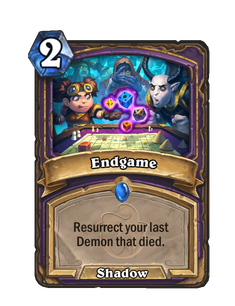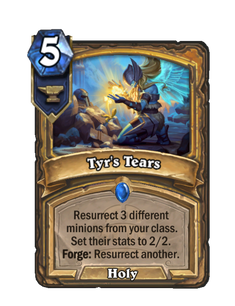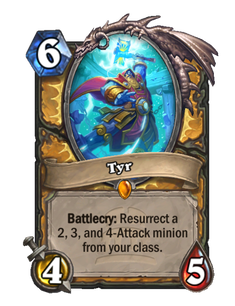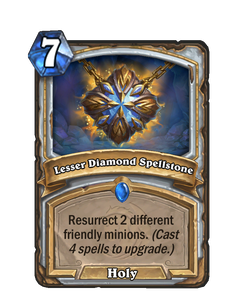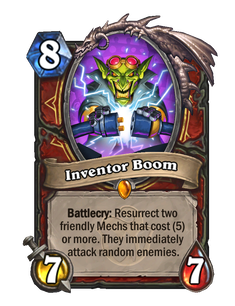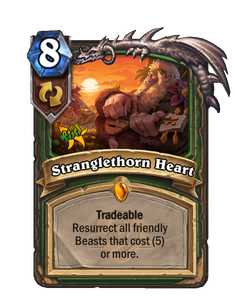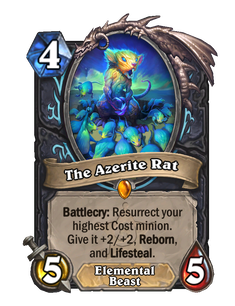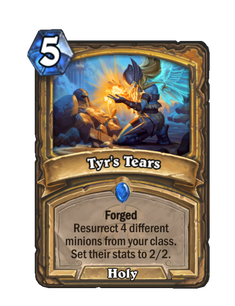Resurrection effect

Resurrection effects are effects that summon copies of minions that have died that game.
Such effects typically phrase themselves as re-summoning or resurrecting the minion that died, but the effect is in fact achieved by summoning a separate copy of the minion.
Notes[edit | edit source]
There are two main types of resurrection effects: those that summon a specific minion when it dies (e.g. ![]() Ancestral Spirit,
Ancestral Spirit, ![]() Redemption), and those that summon one or more minions at least partly randomly from those that have died that game (e.g.
Redemption), and those that summon one or more minions at least partly randomly from those that have died that game (e.g. ![]() Resurrect,
Resurrect, ![]() N'Zoth, the Corruptor). Other types exist, such as
N'Zoth, the Corruptor). Other types exist, such as ![]() Kel'Thuzad.
Kel'Thuzad.
General[edit | edit source]
- The copies summoned are summoned in their base state, at full Health and without any enchantments the original minions had when they died.
Random target[edit | edit source]
- Random target resurrection effects summon random minions from a list of all friendly minion deaths that game, although they sometimes have additional conditions, such as minion type or ability. This includes the death of any minions which were 'friendly' when they died, included those taken control of by effects like
 Mind Control and
Mind Control and  Shadow Madness.[1][2]
Shadow Madness.[1][2]
- Technically, this is achieved through the Death Event Cache, a list that is added to each time a minion dies. Rather than checking a pool of 'dead' minions, resurrection effects check a list of all minion deaths, and select randomly from all eligible instances.
- As per the game's usual rules, only minions that die while in the battlefield are considered to have 'died'. Minions that were transformed, discarded from the hand, overdrawn, or removed from the deck or other zones are not considered to have died, and so will not be summoned.
- Minions such as
 The Skeleton Knight that were returned to hand or shuffled back into the deck when they died are still considered to have died, and so can be summoned by resurrection effects.[3] Each death by any minion will also be recorded on the list separately, even if that minion already died that game.
The Skeleton Knight that were returned to hand or shuffled back into the deck when they died are still considered to have died, and so can be summoned by resurrection effects.[3] Each death by any minion will also be recorded on the list separately, even if that minion already died that game.
- Minions such as
- "Resurrecting" a minion does not remove it from the list of deaths, allowing it to be "resurrected" again later. For example, if on turn 3 you play Injured Blademaster and he then dies, on turn 4 you can play two Resurrects and get two Injured Blademasters.
- Because of this, such effects are more likely to summon copies of a given minion if it has died multiple times that game.[4][5] For example, if 2
 War Golem, 1
War Golem, 1  Magma Rager and 1
Magma Rager and 1  Salty Dog were the friendly minions that had died that game, Resurrect would have a 50% chance of summoning a War Golem, and a 25% chance of summoning a Magma Rager or a Salty Dog.
Salty Dog were the friendly minions that had died that game, Resurrect would have a 50% chance of summoning a War Golem, and a 25% chance of summoning a Magma Rager or a Salty Dog. - If a player summons a copy of a
 Kel'Thuzad who died that turn, at the end of the turn that Kel'Thuzad will summon another copy of the original Kel'Thuzad, resulting in 2 x Kel'Thuzads for the player.[6]
Kel'Thuzad who died that turn, at the end of the turn that Kel'Thuzad will summon another copy of the original Kel'Thuzad, resulting in 2 x Kel'Thuzads for the player.[6]
- Because of this, such effects are more likely to summon copies of a given minion if it has died multiple times that game.[4][5] For example, if 2
- Resurrection effects like N'Zoth will attempt to summon a copy of each eligible minion that died that game. If there is not room on the board to summon a copy of each, N'Zoth will randomly choose which ones to summon.[7]
Strategy[edit | edit source]
Resurrection effects are effective in decks with powerful, high-value minions, as well as those with undesirable Battlecries, such as ![]() Injured Blademaster. Random target resurrection effects are especially effective in combination with
Injured Blademaster. Random target resurrection effects are especially effective in combination with ![]() Barnes and to a lesser extent
Barnes and to a lesser extent ![]() Herald Volazj, which summon 1/1 copies of other minions: once the 1/1 minion is destroyed a copy can be 'resurrected' with full stats. In combination with resurrection effects Barnes also allows players to bring full-stat copies of high-cost minions into play far earlier than normally possible.
Herald Volazj, which summon 1/1 copies of other minions: once the 1/1 minion is destroyed a copy can be 'resurrected' with full stats. In combination with resurrection effects Barnes also allows players to bring full-stat copies of high-cost minions into play far earlier than normally possible.
Cards[edit | edit source]
- For Wild format listings, see Resurrection effect/Wild format.
Collectible
Uncollectible
References[edit | edit source]
- ↑ Ben Brode on Twitter (X). (2015-03-30).
- ↑ Zeriyah on Twitter (X). (2015-03-30).
- ↑ https://www.youtube.com/watch?v=xeMnxQoE728
- ↑ Zeriyah on Twitter (X). (2015-04-01).
- ↑ https://twitter.com/bdbrode/status/766655946479116292
- ↑ Zeriyah on Twitter (X). (2015-03-30).
- ↑ PlayHearthstone on Twitter (X). (2016-03-24).

